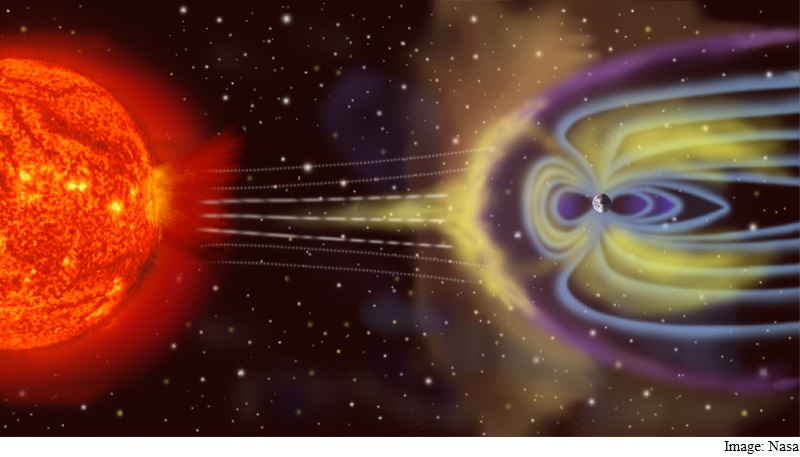- Home
- Science
- Science News
- Earth Like Planets Around Small Stars Likely Have Protective Magnetic Fields: Study
Earth-Like Planets Around Small Stars Likely Have Protective Magnetic Fields: Study

A planet's magnetic field emanates from its core and protect the atmosphere from being lost to space.
Magnetic fields, born from the cooling of a planet's interior, could also protect life on the surface from harmful radiation, as the Earth's magnetic field protects us.
"These preliminary results are promising, but we still do not know how they would change for a planet like Venus where slow planetary cooling is already hindering magnetic field generation," said lead author and astronomer Peter Driscoll from University of Washington.
Driscoll was also curious about the effect of tidal heating on magnetic fields across long periods of time.
The gravitational tug from the star creates tidally generated heat inside the planet or tidal heating.
Tidal heating is responsible for driving the most volcanically active body in our solar system, Jupiter's moon Io.
There has been a general feeling among the astronomers that tidally-locked planets are unlikely to have protective magnetic fields "and therefore are completely at the mercy of their star."
The new research suggests that this assumption is false.
Far from being harmful to a planet's magnetic field, tidal heating can actually help it along and in doing so also help the chance for habitability.
This is because the more tidal heating a planetary mantle experiences, the better it is at dissipating its heat, thereby cooling the core which helps create the magnetic field.
In computer simulations, the team was able to generate magnetic fields for the lifetimes of these planets in most cases.
"I was excited to see that tidal heating can actually save a planet in the sense that it allows cooling of the core. That's the dominant way to form magnetic fields," the authors noted.
Since small or low-mass stars are particularly active early in their lives for the first few billion years or so "magnetic fields can exist precisely when life needs them the most".
"In the future, exoplanetary magnetic fields could be observable, so we expect there to be a growing interest in this field going forward," Driscoll added.
The paper appeared in the journal Astrobiology.
For the latest tech news and reviews, follow Gadgets 360 on X, Facebook, WhatsApp, Threads and Google News. For the latest videos on gadgets and tech, subscribe to our YouTube channel. If you want to know everything about top influencers, follow our in-house Who'sThat360 on Instagram and YouTube.
Related Stories
- Samsung Galaxy Unpacked 2025
- ChatGPT
- Redmi Note 14 Pro+
- iPhone 16
- Apple Vision Pro
- Oneplus 12
- OnePlus Nord CE 3 Lite 5G
- iPhone 13
- Xiaomi 14 Pro
- Oppo Find N3
- Tecno Spark Go (2023)
- Realme V30
- Best Phones Under 25000
- Samsung Galaxy S24 Series
- Cryptocurrency
- iQoo 12
- Samsung Galaxy S24 Ultra
- Giottus
- Samsung Galaxy Z Flip 5
- Apple 'Scary Fast'
- Housefull 5
- GoPro Hero 12 Black Review
- Invincible Season 2
- JioGlass
- HD Ready TV
- Laptop Under 50000
- Smartwatch Under 10000
- Latest Mobile Phones
- Compare Phones
- Moto G15 Power
- Moto G15
- Realme 14x 5G
- Poco M7 Pro 5G
- Poco C75 5G
- Vivo Y300 (China)
- HMD Arc
- Lava Blaze Duo 5G
- Asus Zenbook S 14
- MacBook Pro 16-inch (M4 Max, 2024)
- Honor Pad V9
- Tecno Megapad 11
- Redmi Watch 5
- Huawei Watch Ultimate Design
- Sony 65 Inches Ultra HD (4K) LED Smart TV (KD-65X74L)
- TCL 55 Inches Ultra HD (4K) LED Smart TV (55C61B)
- Sony PlayStation 5 Pro
- Sony PlayStation 5 Slim Digital Edition
- Blue Star 1.5 Ton 3 Star Inverter Split AC (IC318DNUHC)
- Blue Star 1.5 Ton 3 Star Inverter Split AC (IA318VKU)

















